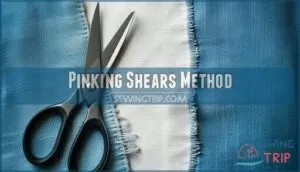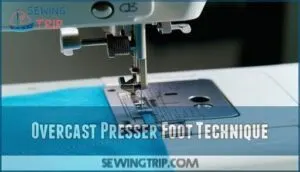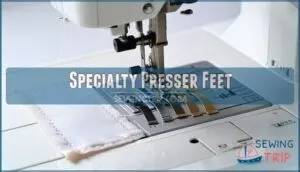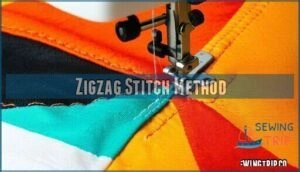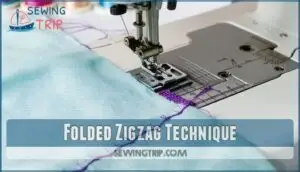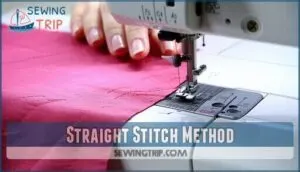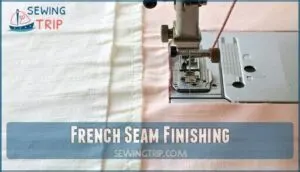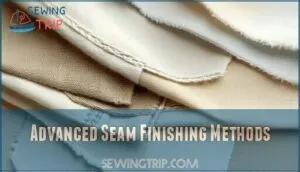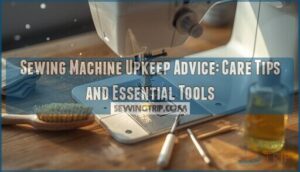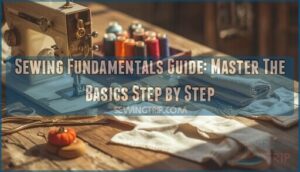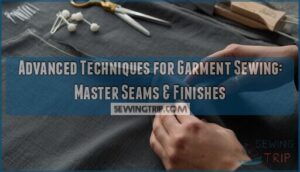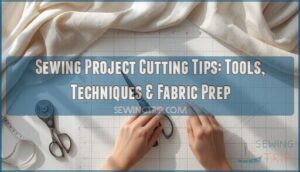This site is supported by our readers. We may earn a commission, at no cost to you, if you purchase through links.
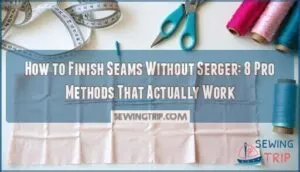
A zigzag stitch on your sewing machine works wonders too; just run it along the raw edge. For a clean, professional look, go for French seams—sew the seam wrong sides together first, then flip and stitch again.
Flat-felled seams are great for strength and durability, especially on jeans. Hem tape is another option for tricky fabrics. Each method has its perks, so pick what suits your project best.
Ready to elevate your sewing game?
Table Of Contents
Key Takeaways
- Use pinking shears or a zigzag stitch on your sewing machine to prevent fraying and keep edges neat.
- Try French seams for lightweight fabrics or flat-felled seams for strength on heavier materials.
- Hem tape offers a quick, no-sew solution, while specialty presser feet can mimic serger-like finishes.
- Match seam finishing techniques to your fabric type for durability and a polished look.
Finishing Seams Basics
When you’re sewing without a serger, finishing your seams isn’t just about making things look pretty—it’s about keeping your fabric from turning into a frayed mess after a few washes.
You’ll prevent those annoying raw edges from unraveling while strengthening your seams, especially on fabrics like cotton, linen, and chiffon that love to fray.
Preventing Fraying
Nothing ruins a handmade project faster than frayed edges unraveling your hard work.
Fray prevention starts with understanding your fabric types—cotton and linen need different seam finishing techniques than silk or wool.
Without a serger, you’ll rely on alternative seam finishes like zigzag stitches or pinking shears.
Edge securing through proper stitch density keeps those pesky threads from wandering off during washing.
Strengthening Seams
Strengthening seams goes beyond just preventing fraying—it’s about creating bulletproof stitching that won’t give out when you need it most.
Your seam finishing techniques without a serger can actually boost durability more than you’d think.
Here’s how proper seam finishing creates rock-solid construction:
- Fabric reinforcement distributes stress across wider areas
- Increased stitch density prevents individual thread breakage
- Stress point protection handles high-tension areas like armholes
- Multiple stitch layers create backup strength systems
- Reinforcement materials add extra support where needed
Essential Fabrics for Seam Finishing
When choosing seam finishes, you’ll find that different fabrics demand different approaches.
Lightweight fabrics like chiffon and silk need gentler techniques, while heavyweight woven fabrics can handle more aggressive finishing methods.
A key reason to finish seams is to prevent fabric fraying, which helps extend the life of your garments.
| Fabric Type | Best Seam Finish | Why It Works |
|---|---|---|
| Woven Fabrics (Cotton, Linen) | Pinking or Zigzag | Fiber content handles standard finishing |
| Knit Fabrics (Jersey, Stretch) | Overcast Stitch | Maintains stretch and flexibility |
| Lightweight Fabrics (Chiffon, Silk) | French Seams | Creates durable seam finishes without bulk |
Finishing Seams Without Serger
Good news: you don’t need a serger to achieve professional-looking seam finishes.
Professional-looking seam finishes are possible with just your sewing machine—no serger required, just creativity and the right techniques.
Regular sewing machines offer plenty of serger alternatives sewing enthusiasts swear by.
Your fabric considerations matter here – lightweight fabrics need gentler approaches, while heavy materials can handle more aggressive finishing methods.
Stitch alternatives include zigzag, overcast, and blanket stitches that prevent fraying just as effectively.
DIY binding using bias tape creates clean, decorative edges without expensive equipment.
Hand finishing might sound old-fashioned, but it’s surprisingly effective for delicate fabrics that machines might damage.
One method involves using pinking shears effectively to create a sawtooth edge.
These easy seam finishes don’t compromise seam durability.
In fact, some methods like French seams actually strengthen your construction.
The key is matching your sewing techniques without serger to your project’s needs.
Whether you’re working with cotton, silk, or denim, there’s a no serger solution that’ll give you those crisp, professional results you’re after.
Tools for Seam Finishing
You don’t need fancy equipment to finish seams like a pro—your basic sewing toolkit already has most of what you need.
The right tools make the difference between edges that fray after one wash and seams that’ll outlast your favorite jeans.
Pinking Shears Method
Pinking shears create zigzag cuts that slow fraying on tightly woven fabrics like cotton and denim.
These serger alternatives sewing tools work best on heavyweight materials that won’t see frequent washing.
Consider where to buy them if you need a pair.
Keep your blades sharp for clean pinking shears seams – dull blades crush fibers instead of cutting them.
This easy seam finishes method offers decent edge durability with minimal effort required, making it a great option for those looking for a simple way to finish their seams with minimal effort.
Overcast Presser Foot Technique
Your overcast presser foot mimics serger-quality finishes right on your sewing machine.
This specialized foot guides fabric edges while creating zigzag overcast stitches that prevent fraying.
Adjust stitch settings between 2-3mm length for best results.
The foot works beautifully on curved seams and handles various fabric weights.
Most sewing machines accept these affordable feet, making professional seam finishing accessible without expensive equipment.
These feet often feature a metal finger bar to prevent fabric bunching.
Hem Tape Application
Hem tape offers a quick no-sew solution when you’re pressed for time.
This adhesive strip bonds fabric edges together using heat from your iron. Choose fusible web types for lightweight fabrics or paper-backed varieties for heavier materials.
Application techniques vary by brand, but most require pressing for 10-15 seconds.
Remember to use sharp fabric scissors for clean cuts.
Check fabric compatibility first—some synthetics don’t bond well, which is a critical consideration.
Specialty Presser Feet
Specialty presser feet transform your regular sewing machine into a seam-finishing powerhouse. These attachments offer serger alternatives that’ll make your edges look professionally finished. Different foot types match specific fabric compatibility needs, while proper stitch settings and tension adjustment guarantee perfect results.
Many sewers find that specialty presser feet enhance efficiency and accuracy.
Essential sewing machine presser feet include:
- Overcast presser foot – mimics serger stitching for clean edges
- Zigzag foot – handles stretchy fabrics with adjustable stitch width
- Walking foot – prevents fabric shifting during seam finishing
Regular maintenance tips keep these tools performing flawlessly.
Seam Finishing Techniques
You’ve got your tools ready, so now it’s time to master the core techniques that’ll keep your fabric edges neat and fray-free.
These four essential methods work with any standard sewing machine and will give you professional results that rival expensive serger finishes.
Zigzag Stitch Method
The zigzag stitch transforms your regular sewing machine into a fraying fighter.
Adjust your stitch width between 2-4mm and stitch length to 1-2mm based on fabric type. Heavier fabrics need wider settings, while delicates require narrower ones.
Choose a universal needle and adjust tension if stitches pucker. This versatile technique works on straight and curved seams alike.
For swimwear, this method offers needed flexibility, but remember to select polyester thread for chlorine resistance.
Folded Zigzag Technique
For a polished finish, the folded zigzag technique is a lifesaver.
Fold your seam allowance, then secure it with a zigzag stitch.
Adjust the stitch width for fabric compatibility and use these tips:
- Stitch Adjustment: Match stitch size to fabric weight.
- Cornering Technique: Slow down for crisp corners.
- Curve Application: Guide fabric gently.
- Thread Selection: Choose durable, matching thread.
Straight Stitch Method
If you’re after a simple folding technique for a clean finish, the straight stitch method is a winner.
Just fold your seam allowance under, press it flat, and sew along the edge.
It’s perfect for beginners mastering sewing techniques and works well for most fabrics.
This method balances durability factors with ease, making seam finishes look polished and professional.
French Seam Finishing
French seams are a game-changer for sheer fabrics and curved seams.
They’re perfect when durability factors and a professional finish matter.
To master this sewing technique, stitch the fabric wrong sides together first, trim, then sew right sides together.
This double-seam method reduces bulk and completely encloses raw edges, making it a must-know from sewing tutorials, especially for beginners aiming for polished seam finishes.
Advanced Seam Finishing Methods
If you’re ready to level up your sewing game, advanced seam finishing methods can give your projects a polished, professional touch.
These techniques might take a bit more effort, but they’re worth it for durable, clean seams that stand out.
Overlock Stitch Without Serger
If you’re sewing without a serger, an overlock stitch is your go-to for neat edges.
Most sewing machines can mimic it with a zigzag stitch and an overcast presser foot.
Here’s how:
- Adjust tension for smooth stitching.
- Use polyester thread for durability.
- Test stitch settings on scrap fabric.
- Pair with stretchy or woven fabrics for best results.
Flat-Felled Seam Technique
If you’re after durability benefits and a polished look, the flat-felled seam is your go-to.
Perfect for fabric compatibility with denim or medium-weight cotton, this industrial-strength finish encases raw edges neatly.
Start with wrong sides together, trim one allowance, fold the other over, and secure with topstitching. Just skip curved seams—this one’s for straight lines only, making it ideal for projects requiring a polished look.
Double-Seamed Method
If flat-felled seams feel too bulky, the double-seamed method is your next go-to.
It’s all about sewing the seam twice for added durability.
Perfect for fabric compatibility across lightweight to medium materials, this technique reduces bulk while keeping edges tidy.
Bonus? It works great on straight seams and curves, giving your projects a professional finish without a serger, and is particularly useful for achieving a clean look on various types of fabric, making it a versatile technique.
Pre-Fold Hand Stitched Method
If you’re tackling piled fabric finishes like velvet or thick wool seams, the pre-fold hand stitched method is a lifesaver.
Simply pre-fold seam binding, pin it in place, and use hand-sewn seams to prevent shifting.
This seam binding technique guarantees a clean, durable edge. It’s slower than other sewing techniques without a serger, but the results? Totally worth it.
Frequently Asked Questions (FAQs)
Do I need a serger to finish seams?
You don’t need a serger.
You can use pinking shears, zigzag stitches, or even hem tape.
These methods keep edges tidy and fray-free, and they work great with a regular sewing machine.
How to finish seams with a serger or tight stitches?
To finish seams with a serger, use an overlock stitch for clean edges.
Without a serger, try zigzag stitches or pinking shears.
Both methods prevent fraying and keep your fabric looking polished and durable.
Does a serger replace a sewing machine?
Think of a serger as the sprinter and a sewing machine as the marathoner.
A serger speeds up seam finishing, but it doesn’t replace the versatility or precision your sewing machine offers for other tasks.
How to finish a seam without sewing?
You can use hem tape for a no-sew solution.
Just place it along the raw edge, fold the fabric over, and press with an iron.
It’s quick, easy, and keeps fraying in check!
How to choose thread for seam finishing?
Pick a thread matching your fabric’s weight and color.
For durability, go with polyester or cotton-poly blends.
Avoid cheap threads—they fray easily and weaken seams.
A good thread makes all the difference in finishing, with durability being key to a well-made product.
What are common mistakes in seam finishing?
Don’t worry, everyone’s made these mistakes: skipping seam finishes, using the wrong stitch for fabric type, or cutting seam allowances too small.
Avoid rushing—uneven stitches or frayed edges can turn your project into a headache, as this can lead to issues like frayed edges.
How to finish seams on stretchy fabrics?
Stretchy fabrics need flexible finishes.
Try a zigzag or stretch stitch to keep seams intact. Fold edges and sew for clean lines, or use hem tape for quick fixes.
Always test stitches on scraps first!
Can seam finishes affect garment flexibility?
Seam finishes can impact flexibility.
A bulky finish might stiffen the fabric, while lighter methods like pinked or zigzag seams keep it soft and stretchy.
Choosing the right finish guarantees comfort and movement.
How to finish seams on curved edges?
Did you know 70% of sewing mistakes happen on curves?
For curved seams, use a zigzag stitch or pinking shears.
Clip notches into the seam allowance to prevent puckering and keep the curve smooth.
Conclusion
Who needs a serger when you’ve got these game-changing techniques?
Finishing seams without a serger isn’t just possible—it’s downright easy with the right tools and methods.
From zigzag stitches to French seams, you’ve got plenty of options to keep your projects looking polished and professional.
Just grab your pinking shears, set up your sewing machine, and experiment with what works best for your fabric.
Your sewing game’s about to level up big time!


